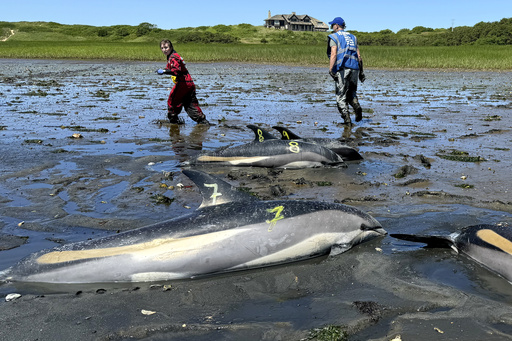The recent stranding of over 100 dolphins on Cape Cod, making it the largest known dolphin stranding event in U.S. history, is influenced by the peninsula’s geographic features. Cape Cod’s gently sloping sand flats, tidal changes, and proximity to productive feeding areas are contributing factors. The hook-like shape of the cape itself has made Cape Cod a global hotspot for dolphin mass strandings.
Rescuers who assisted in freeing more than a hundred dolphins from the shorelines last month have confirmed that the mass stranding, which began on June 28, was the largest in the U.S. A recent review of data and aerial imagery revealed that 146 dolphins were involved, with 102 dolphins surviving the event. Unfortunately, 37 dolphins died naturally, and seven had to be euthanized.
Brian Sharp, the director of marine mammal rescue at the International Fund for Animal Welfare, states that dolphins strand more frequently on Cape Cod than on any other U.S. shoreline. A study over a decade found that 25% of dolphin strandings in the U.S. happened on Cape Cod, mostly along a 16-mile stretch of coastline. In 2012 alone, the group responded to 32 mass strandings on the cape.
The geographic challenges of Cape Cod, such as gently sloping beaches, fine sand, mud flats, and significant tidal fluctuations, can lead to dolphins becoming stranded. Dolphins swimming too close to shore at high tide could find themselves stranded as the tide recedes. These conditions also make it difficult for dolphins to rely on echolocation.
Rescuers are observing an increase in summer mass strandings, although these events typically occur between December and April. They are investigating if climate change and the movement of bait fish closer to the shore play a role. Additionally, sea turtles can also get trapped in Cape Cod’s fishhook topography during warmer months, requiring rescue and rehabilitation efforts.
Response efforts to these strandings have continued on a smaller scale. For instance, nine Atlantic white-sided dolphins were rescued, relocated, and released on July 2 after being found stranded near Powers Landing in Wellfleet, Massachusetts. Efforts involved guiding the dolphins back to open water, with some challenges such as difficult mud conditions and the spread-out nature of the dolphins.
Satellite tags have been used to track the dolphins sent back offshore. Reports have indicated that some of the dolphins, identified by temporary markings, are now swimming among larger groups of dolphins that were not part of the stranding event.
